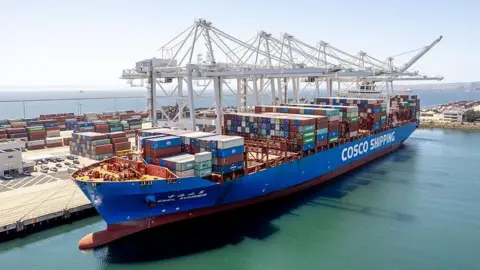The United States has recently announced a strategic plan designed to impose port fees on Chinese ships as part of a broader agenda to strengthen domestic shipbuilding capabilities while countering China’s growing influence in the maritime industry. This initiative follows ongoing tensions in trade relations and is reflective of the Trump administration’s push to recalibrate trade dynamics in favor of U.S. interests. The U.S. Trade Representative (USTR) released these details, emphasizing that they aim to revive the American shipbuilding sector while addressing concerns that China’s expansion in this area has often come at the expense of U.S. companies.
This latest announcement, made on April 18, 2025, outlines a more measured approach compared to an earlier proposal introduced in February, which would have levied exorbitant fees—up to $1.5 million—on Chinese vessels entering American ports. Instead, the new fees are set to be implemented within 180 days, with incremental increases anticipated over the upcoming years. The USTR has acknowledged that while the newly proposed fees are significant, they also need to balance the potential repercussions on global trade, which might be aggravated by the U.S. government’s existing tariff policies.
In their statement, the USTR made clear that the introduction of such fees is a response to the competitive imbalances created by China, indicating that “China has largely achieved its dominance goals, severely disadvantaging U.S. companies, workers, and the U.S. economy.” Consequently, the specific reporting structures of the fees will depend on various factors, including cargo weight, the number of containers carried, and vehicles on board.
For bulk vessels owned and operated by Chinese firms, initial fees will start at $50 per ton, surging by an additional $30 per ton each year for the next three years. Meanwhile, container ships manufactured in China will face fees beginning at $18 per ton or $120 per container, again escalating over time. Additionally, ships not built in the U.S. that are transporting vehicles will incur a charge of $150 per vehicle. Importantly, these fees are designed to be applied once per voyage for a maximum of six times a year, a reduction from earlier proposals that had targeted fleet sizes and future orders.
The USTR has also designated certain exemptions to mitigate backlash. For instance, empty vessels arriving at U.S. ports to load bulk exports like coal and grain will be exempt from these fees. Furthermore, there are plans for a second phase of initiatives aimed at prioritizing U.S.-built ships transporting liquefied natural gas (LNG), which will gradually tighten regulations over a two-decade timeline.
This announcement comes at a crucial time when global trade patterns are being reshaped by ongoing tariff disputes, particularly under President Trump’s administration. To illustrate the shift, reports indicate that cargo originally intended for American ports is now being rerouted to European destinations. Such developments have raised alarms among industry experts, as they warn that these changes could lead to increased consumer prices and disruptions in supply chains.
In conjunction with these tariff adjustments, Trump has implemented a series of heightened import taxes on Chinese goods that could reach as high as 245%. The impact has already manifested in significant delays and congestion at major ports, especially in the EU and the UK, straining logistics and amplifying costs for American consumers. As a result, many companies are currently forced to re-evaluate and redesign their supply chains to adapt to this evolving landscape, signaling a potential shift that could redefine global trade routes and practices.
The situation continues to develop, leaving businesses and economists to speculate on the long-term effects of these fees and tariffs on international commerce, as both the U.S. and its trading partners navigate through a period of heightened economic uncertainty and competition. Analysts like Sanne Manders, president of logistics firm Flexport, warn of compounded congestion at major ports and the necessity for shippers to establish new market opportunities in light of these shifts. As the administration’s strategies unfold, the broader implications for global trade dynamics and economic conditions remain to be seen.











